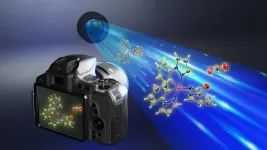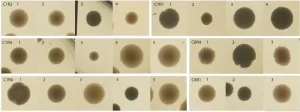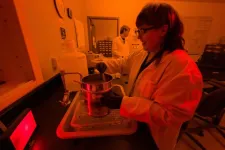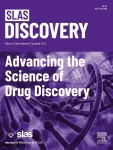(Press-News.org) Analysis of Global Positioning System (GPS) time-series data from nearly 100 large earthquakes worldwide has provided evidence for the existence of a precursory phase of fault slip occurring two hours before seismic rupture. “If it can be confirmed that earthquake nucleation often involves an hours-long precursory phase, and the means can be developed to reliably measure it, a precursor warning could be issued,” writes Roland Bürgmann in a related Perspective. The ability to predict large earthquakes has been a longstanding yet elusive goal. Short-term earthquake prediction – the ability to issue a warning from minutes to months before a quake occurs – relies on a definitive and observable geophysical precursor signal. Previous retrospective studies of several large earthquakes have suggested that a precursory phase of slow aseismic slip can be observed in faults before a mainshock. However, the relationship between these observations and seismic ruptures is poorly understood as they don’t directly precede an event and occur frequently without being followed by an earthquake. As a result, the existence of a clear precursory signal capable of predicting large earthquakes remains uncertain. Here, Quentin Bletery and Jean-Mathieu Nocquet present a systematic global search for short-term precursory fault slip before large earthquakes. Using global high-rate GPS time series data from 3,026 geodetic stations worldwide, Bletery and Noquet measured fault displacement up to two hours before 90 different magnitude 7 and above earthquakes occurred. Statistical analysis of the data revealed a subtle signal consistent with a period of exponential acceleration of fault slip near the eventual earthquake’s hypocenter beginning roughly two hours before the rupture. According to the authors, the findings suggest that many large earthquakes start with a precursory phase of slip or that the observations represent the tail end of a much longer and more difficult-to-measure process of precursory slip. Although the study offers evidence of a precursory signal heralding large earthquakes, Bletery and Noquet note that currently deployed earthquake monitoring instrumentation lacks the coverage and precision required to identify or monitor for precursory slip at the scale of individual earthquakes. “Although the results of Bletery and Nocquet suggest that there may indeed be an hours-long precursory phase, it is not clear whether such slow-slip accelerations are distinctly associated with large earthquakes or whether they could ever be measured for individual events with the accuracy needed to provide a useful warning,” writes Bürgmann.
END
Global GPS measurements indicate observable phase of fault slip two hours before large earthquakes
Summary author: Walter Beckwith
2023-07-20
ELSE PRESS RELEASES FROM THIS DATE:
Biobank-scale imaging data unveils the genetic architecture of the human skeletal form
2023-07-20
Combining data from full-body x-ray images and associated genomic data from more than 30,000 UK Biobank participants, researchers have helped illuminate the genetic basis of human skeletal proportions. The findings not only provide new insights into the evolution of the human skeletal form and its role in musculoskeletal disease, but they also demonstrate the utility of using population-scale imaging data from biobanks to understand both disease-related and normal physical variation among humans. Of all primates, humans are the only ones to have evolved to be normally bipedal, an adaptation that may have facilitated the use of tools and accelerated cognitive development. ...
Genes that shape bones identified, offering clues about our past and future
2023-07-20
Using artificial intelligence to analyze tens of thousands of X-ray images and genetic sequences, researchers from The University of Texas at Austin and New York Genome Center have been able to pinpoint the genes that shape our skeletons, from the width of our shoulders to the length of our legs.
The research, published as the cover article in Science, pulls back a curtain on our evolutionary past and opens a window into a future where doctors can better predict patients’ risks of developing conditions such as back pain or arthritis in later life.
“Our research is a powerful demonstration of the impact of AI in medicine, particularly when it comes to analyzing ...
Immune systems develop ‘silver bullet’ defences against common bacteria
2023-07-20
Immune systems develop specific genes to combat common bacteria such as those found in food, new research shows.
Previous theories have suggested that antimicrobial peptides – a kind of natural antibiotics – have a general role in killing a range of bacteria.
However, the new study, published in Science, examined how the immune systems of fruit flies are shaped by the bacteria in their food and environment.
The researchers, from the Swiss Federal Institute of Technology and the University of Exeter, found two peptides that each control a single bacterial species commonly encountered by the flies.
“We know that an animal’s food and environment ...
These bones were made for walking
2023-07-20
NEW YORK, NY--Perhaps the most profound advance in primate evolution occurred about 6 million years ago when our ancestors started walking on two legs. The gradual shift to bipedal locomotion is thought to have made primates more adaptable to diverse environments and freed their hands to make use of tools, which in turn accelerated cognitive development. With those changes, the stage was set for modern humans.
The genetic changes that made possible the transition from knuckle-based scampering in great apes to upright walking in humans have now been uncovered in a new study by researchers ...
Observing the long-postulated intermediate of catalytic amination reactions
2023-07-20
Led by Director CHANG Sukbok, scientists from the Center for Catalytic Hydrocarbon Functionalizations within the Institute for Basic Science (IBS) have made a breakthrough in understanding the structure and reactivity of a key intermediate in catalytic reactions. This intermediate, known as a transition metal-nitrenoid, plays a crucial role in converting hydrocarbons into amides, which are important in pharmaceuticals and materials science.
In chemical reactions, intermediates are substances that are formed and consumed during the transformation of reactants into products. Hence, understanding these intermediates ...
Living together: Microbial communities are more than the sum of their parts
2023-07-20
Microbial communities are widely used biotechnology suppliers for processes like manufacturing biofuels and new foods, or helping crops grow better. To engineer successful communities, scientists need to predict whether microorganisms can live and work together. One popular predictive rule states that if a pair of microbes will coexist, they will also coexist in a bigger community of microbes. A study published in Science now found that this simple rule will not always work.
Just like plants and animals, microorganisms live in complex ecological communities consisting of multiple species that ...
Greenland has greener history than previously thought, says USU Geoscientist
2023-07-20
LOGAN, UTAH, USA -- New analysis of samples collected from underneath Greenland’s ice sheet reveal the Arctic island was much greener as recently as 416,000 years ago. The findings overturn previous views that Greenland’s continental glacier, which covers about 80 percent of the 836,3000-square-mile land mass, has persisted for the last two and a half million years.
“We’re discovering the ice sheet is much more sensitive to climate change than we previously thought,” says Utah State University geoscientist ...
New advancements in assay development research
2023-07-20
Oak Brook, IL – The July 2023 issue of SLAS Discovery, the open access journal focused on research progressing drug discovery, is now available. Volume 28, Issue 5, contains one short communication and four full-length articles covering assay quality metrics, fluorescence resonance energy transfer (FRET) and small molecule glycomimetics and other high-throughput screening-related research.
Full-length articles
Mathematical relationships between control group variability and assay quality metrics
Authored by early ...
The present and future of computing get a boost from new research
2023-07-20
The world's computing needs have grown exponentially in recent years due to an explosion of technology. To meet the needs for the next technological leap, the scientific community is working to improve current processing capabilities and simultaneously develop entirely new computing methods.
Two new papers from the research group of Jean Anne Incorvia, a professor in the Cockrell School of Engineering’s Chandra Family of Electrical and Computer Engineering, aim to contribute to both of these scientific needs. Together, they offer improvements ...
The largest study of its kind shows a need for improvement in esophageal cancer screenings
2023-07-20
A new study published in Gastroenterology aims to improve the effectiveness of screening and surveillance practices for early cancer detection in Barrett’s esophagus (BE).
BE is the only identifiable precursor lesion for esophageal adenocarcinoma (EAC), a lethal cancer with increased incidence and mortality rates over the last several decades.
The research, led by faculty at the University of Colorado (CU) Cancer Center, analyzed a large international database of over 20,000 newly diagnosed BE patients in Nordic countries to provide a more accurate look at how many patients have normal ...
LAST 30 PRESS RELEASES:
Plant hormone allows lifelong control of proteins in living animal for first time
Swedish freshwater bacteria give new insights into bacterial evolution
Global measures consistently underestimate food insecurity; one in five who suffer from hunger may go uncounted
Hidden patterns of isolation and segregation found in all American cities
FDA drug trials exclude a widening slice of Americans
Sea reptile’s tooth shows that mosasaurs could live in freshwater
Pure bred: New stem cell medium only has canine components
Largest study of its kind highlights benefits – and risks – of plant-based diets in children
Synergistic effects of single-crystal HfB2 nanorods: Simultaneous enhancement of mechanical properties and ablation resistance
Mysterious X-ray variability of the strongly magnetized neutron star NGC 7793 P13
The key to increasing patients’ advance care medical planning may be automatic patient outreach
Palaeontology: Ancient tooth suggests ocean predator could hunt in rivers
Polar bears may be adapting to survive warmer climates, says study
Canadian wildfire smoke worsened pediatric asthma in US Northeast: UVM study
New UBCO research challenges traditional teen suicide prevention models
Diversity language in US medical research agency grants declined 25% since 2024
Concern over growing use of AI chatbots to stave off loneliness
Biomedical authors often call a reference “recent” — even when it is decades old, analysis shows
The Lancet: New single dose oral treatment for gonorrhoea effectively combats drug-resistant infections, trial finds
Proton therapy shows survival benefit in Phase III trial for patients with head and neck cancers
Blood test reveals prognosis after cardiac arrest
UBCO study finds microdosing can temporarily improve mood, creativity
An ECOG-ACRIN imaging study solves a long-standing gap in metastatic breast cancer research and care: accurately measuring treatment response in patients with bone metastases
Cleveland Clinic presents final results of phase 1 clinical trial of preventive breast cancer vaccine study
Nationally renowned anesthesiology physician-scientist and clinical operations leader David Mintz, MD, PhD, named Chair of the Department of Anesthesiology at the UM School of Medicine
Clean water access improves child health in Mozambique, study shows
Study implicates enzyme in neurodegenerative conditions
Tufts professor named Fellow of the National Academy of Inventors
Tiny new device could enable giant future quantum computers
Tracing a path through photosynthesis to food security
[Press-News.org] Global GPS measurements indicate observable phase of fault slip two hours before large earthquakesSummary author: Walter Beckwith





